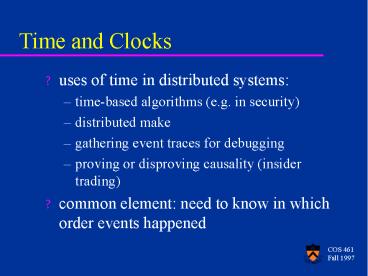Time and Clocks - PowerPoint PPT Presentation
Title:
Time and Clocks
Description:
handling time zones, daylight savings time, year 2000, etc. COS 461. Fall 1997 ... represent a logical time as a vector with P entries (assuming P processes) ... – PowerPoint PPT presentation
Number of Views:372
Avg rating:3.0/5.0
Title: Time and Clocks
1
Time and Clocks
- uses of time in distributed systems
- time-based algorithms (e.g. in security)
- distributed make
- gathering event traces for debugging
- proving or disproving causality (insider trading)
- common element need to know in which order
events happened
2
Absolute Time
- this is what clocks tell us
- strategy keep clocks synchronized put
time-stamp on each event - problems
- hard to synchronize distributed clocks
- clock speeds vary unpredictably
- handling time zones, daylight savings time, year
2000, etc.
3
Synchronizing Clocks
- many protocols exist
- NTP (Network Time Protocol) standard
- will discuss simpler protocol here
- use reference clock as baseline
- Coordinated Universal Time (UCT)
- from atomic clocks run by NIST
- other machines try to sync with UCT
4
Clock Synchronization Protocol
- A sends to B My clock says ltvaluegt
- only possible building block
- problem message takes time to get to B
- network delay is unknown and variable
- work-around measure round-trip time between A
and B, assume it doesnt vary much and that delay
is equal in both directions - not completely accurate
5
Clock Synchronization Problems
- synchronization is necessarily inaccurate
- happens before judgements might be wrong
- can get out of sync badly if network is
partitioned - vulnerable to dishonest time-servers
- bottom line OK for some applications
- alternative logical time
6
Logical Time
- insight often dont care about when something
happened, only about which thing happened first - logical time talks about happened before
relationships, without reference to absolute time - (analogies to Einsteins relativity are common
but bogus)
7
Example
Process P1
Process P2
Process P3
8
The Happened Before Relation
- X --gt Y means X happened before Y
- captures logical ordering, not temporal
- three rules
- if X and Y occur in the same process, and X
occurs before Y, then X --gt Y - if M is a message, then send(M) --gt receive(M)
- if X --gt Y and Y --gt Z, then X --gt Z
9
Example
Process P1
Process P2
Process P3
10
Logical Time Relationships
- Given two events X and Y, either
- X --gt Y, or
- Y --gt X, or
- neither
- X and Y are concurrent
- X could not have caused Y, and vice versa
- --gt relation defines a partial order
- How to determine --gt in practice?
11
Logical Timestamp Algorithms
- simple algorithms to capture --gt
- assign numerical timestamp to each event
- no relation to absolute time
- simple timestamps
- if X --gt Y, then TS(X) lt TS(Y)
- vector timestamps
- X --gt Y if and only if TS(X) --gt TS(Y)
12
Simple Logical Timestamps
- timestamp is an integer
- each process has a logical clock
- starts at zero
- incremented on each local event
- each message has a timestamp
- equal to senders logical clock when sent
- on receive, receivers logical clock set to 1
max(message timestamp, receivers previous
logical clock)
13
Logical Timestamp Example
Process P1
1
2
0
Process P2
0
3
4
Process P3
0
1
5
14
Simple Logical Timestamps
- successfully capture all --gt relationships
- also capture some false relationships
- TS(X) lt TS(Y) but not X --gt Y
- good scheme to use if extra ordering isnt a
problem - otherwise, need something fancier
15
Vector Timestamps
- captures --gt exactly
- more complicated than simple timestamps
- uses more time and space
- represent a logical time as a vector with P
entries (assuming P processes) - each process has logical clock
- each message has a logical timestamp
16
Vector Timestamp Algorithm
- local event in process I
- process I increments the Ith element of its
logical clock - message sent
- message timestamp logical clock of sender
- message received
- for all J, receiver sets Jth element of logical
clock to max of - Jth component in message timestamp
- Jth component in receivers logical clock
17
Vector Time Example
(1,0,0)
(2,0,0)
(2,2,0)
(2,1,0)
(2,2,2)
(0,0,1)
18
Vector Time and Ordering
- given two events X and Y,
- X --gt Y iff some XiltYi and all XiltYi
- Y --gt X iff some YiltXi and all YiltYi
- X Y iff some XiltYi and some XjgtYj
- captures happened-before relation exactly
19
Interpreting Vector Time
- each process numbers its events sequentially
- represented by Ith element of process Is clock
- each process keeps track of which events on other
processes have happened before the present time - if the Ith element of Ps clock is N, that means
that the first N events at I happened before the
present on process P
20
Application Event Logging Tool
- maintain vector logical clocks
- each process dumps events of interest to a local
file - mark with logical timestamp
- postmortem analysis tool can interleave the local
traces correctly - can answer questions of possible causality
21
Critique of Logical Time
- fine for some applications, but
- doesnt capture all of the real relationships
- messages can flow outside the system
- insider trading example
- happened before doesnt capture causality
- absolute time has this problem too































